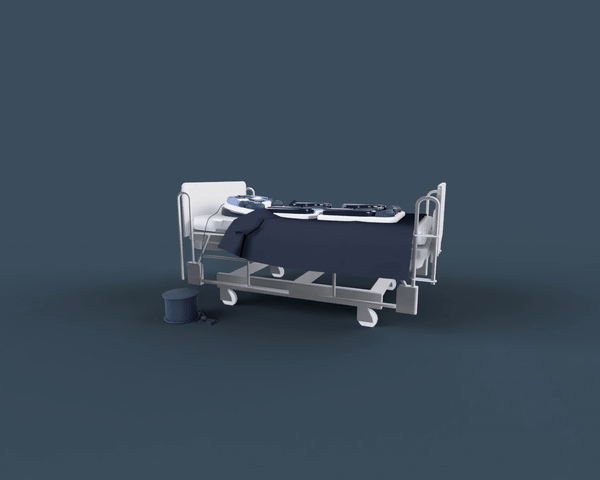MISION
PROTO'S
Understanding Protontherapy
Dealing with Chemotherapy
Challenge
Facilitating communication between doctors, parents and kids (ages 4-12) dealing with cancer treatments. Design to guide and properly explain fundamentals, processes, secondary effects, procedures and overall pediatric cancer treatments.
Constraints
Total adoption
Positive emotional conection
Sterilizable materials
Personalizable
Neutral
Tools
CAD + 3D printing
Illustration + Storytelling
Emotional inteligence
Adobe suite (Ai, Ch, Ae)
Main Takeaways
1. Design for healthcare is vital.
2. Kids are wiser than we think.
3. Play can heal, even adults.
4. Importance of visual and verbal communication through motion graphics.
Client
Clínica Universidad de Navarra
AIR-REST IQ
An affordable mechanism that allows critical care nurses or caretakers to address patients in acute respiratory distress into a prone position while reducing incidence of pressure injuries.
Challenge
Reducing pressure uclers for patients in respiratory distress that need prone positioning for extended periods of time
Constraints
Costumizable
Full absorbtion
Integrate ICU workflow
Sterilizable
Affordable
Requirements
Provide space for ventilator
Accomodates up to 300lbs
Improves nurses workflow
Minimizes shear force
Ulcer reduction
Tools
CAD modeling
Simulation
Textile & material exploration
Animation
Field research
Expert interviews
collaboration
Main Takeaways
1. Aim to focus on the most important design parameters - solved the most pressing problems.
2. Product is reasonably easy to reproduce and manufacture large scale
3. Ulcer incidence reduction (compared to existing solutions) is significant
Collaborators
Leon Zhao, Riley Renee Flores, Maria Claudia Chu
Deep Dive Research
What's the problem?
The cure is worse than the disease
The use of prone positioning methods are exponentially increasing because of the current circumstances and even though it can be really effective, getting the patient into the position is a challenge that requires an adequate number of personnel.
Proning allows the back of the lungs to expand fully with less restriction so it improves breathing and overall oxygen traveling through the body, but patients that require it for extended periods of time are exposed to stage 4 pressure ulcers that involve face and skin reconstruction as a result.
The efficacy of current solutions seems to be the biggest gap in the prone pillow market. Today, 2.5 million patients per year are affected by pressure ulcers developed in their hospital stays and there is no design available that is directly dealing with this increasing number. The gap in the landscape is not a lack of alternatives, it’s a lack of addressing the issue in its entirety.





Need statement
What we looked for.
The goal was identifying the gaps that have not yet been looked into and gathering of supporting data from past procedures that provide insights to develop a reliable, cost effective and customizable mechanism that sustains ICU patients during prone positioning while reducing pressure injuries.
The prone position has been formally used since 1970 and its main goal was to provide less restriction and open the diaphragm for patients in the ICU to be able to breathe easily and get better oxygenation through the body.



The range of existing designs that address prone positioning are surprisingly substantial, yet no design has been tailored to successfully avoid the consequences of pressure points in varying body morphologies.
Existing design solutions focus more in the shape to properly accommodate the individual, without considering the negative aftermath of staying in the resting position for a long period of time.
Existing solutions


Key innovations
1. The Individually Inflatable Cells: each air cell deflates and inflates depending on the need.
2. Customizable: modular design that can be adapted accordingly to each face shape.
3. Adjustable: option to place head face down or side profile down.





